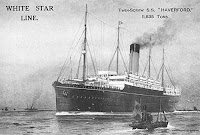Finally, in February 1916 orders were again received that the Regiment were to go abroad and that they would sail on 3 March 1916.
The last parade of the Regiment in Norfolk took place at 7:30pm on the evening of 2 March before marching to Lowestoft Station. The train finally left Lowestoft at 8:45pm bound for Devonport.
It is at this time that the Cheshire Yeomanry War Diary commences. A War Diary is a daily record of operations, intelligence reports and other events, kept for each battalion by an appointed officer. It is not a personal diary. Specialist units, such as military hospitals, also kept war diaries.
The War Diary of Cheshire Yeomanry for this period is concise, recording just the barest of facts:
| Place | Date | Hour | Summary of Events |
| Lowestoft | 1/3/16 | Regiment in billets at Lowestoft | |
| 2/3/16 | 8.45pm | Regiment entrained at Lowestoft | |
| 3/3/16 | 9.30am | Arrived at Devonport & embarked on HMT Haverford | |
| 6pm | Left Devonport. Strength 25 Officers. Other Ranks 451 |
 |
| HMT Haverford |
HMT Haverford was a 12,000 ton troop ship, originally a passenger cargo vessel, built in 1901.
Destination was thought to be Egypt, but due to the threat from submarines the departure was guarded with the utmost security and only the Colonel therefore knew definitely the destination. The Haverford sailed on 3 March and for the most part of the voyage was unescorted. Gibraltar was reached on the evening of 7 March without incident. Here she was challenged by lamp signal to give identity and destination. Lt.-Col. Sir Richard Verdin in his history of the Cheshire Yeomanry takes up the story:
"Incredibly, the ship’s signal light flashed back in ordinary morse stating that she was H.M.T. Haverford from Devonport, proceeding to Alexandria with 1,200 passengers aboard. Those able to read morse knew definitely for the first time where they were going. So, no doubt, would every enemy agent watching from the North African coast to whom the signals would have been clearly visible in the excellent weather condition at the time."Cheshire Yeomanry, together with Shropshire Yeomanry and Denbighshire Yeomanry, formed the Welsh Border Mounted Brigade. The South Wales Mounted Brigade comprised Pembroke Yeomanry, Montgomery Yeomanry and Glamorganshire Yeomanry.
|
|
A second ship, HMT Arcadian, would sail from Devonport on 4 March. The 2,500 troops on board included the whole of the South Wales Mounted Brigade and also personnel of the Welsh Border Mounted Brigade for whom there had been insufficient room on the Haverford; this included the Shropshire Yeomanry.
On 10 March the Arcadian overtook the Haverford, and both vessels arrived safely at Alexandria on 14 March 1916.


No comments:
Post a Comment